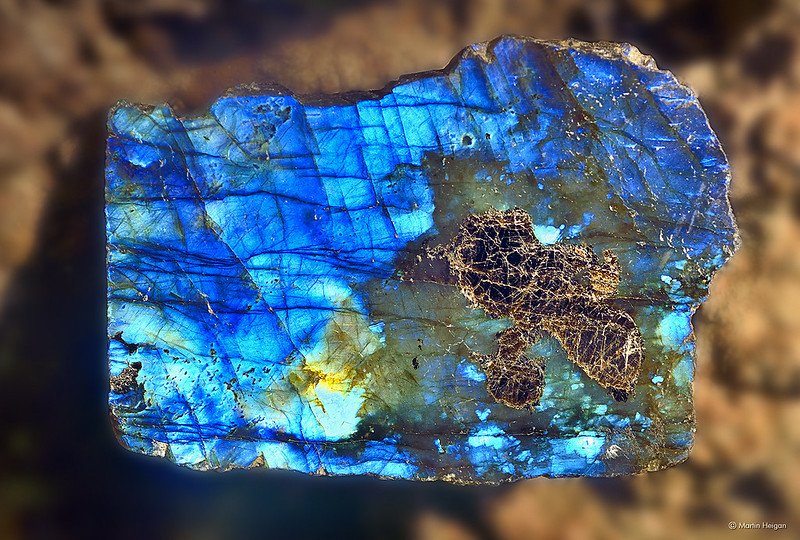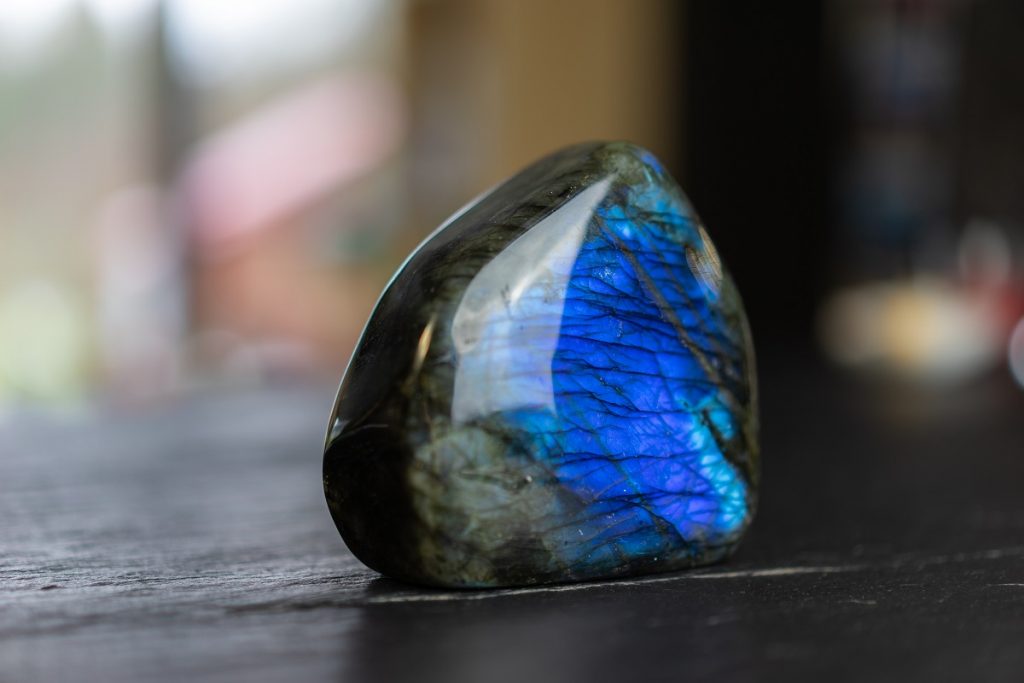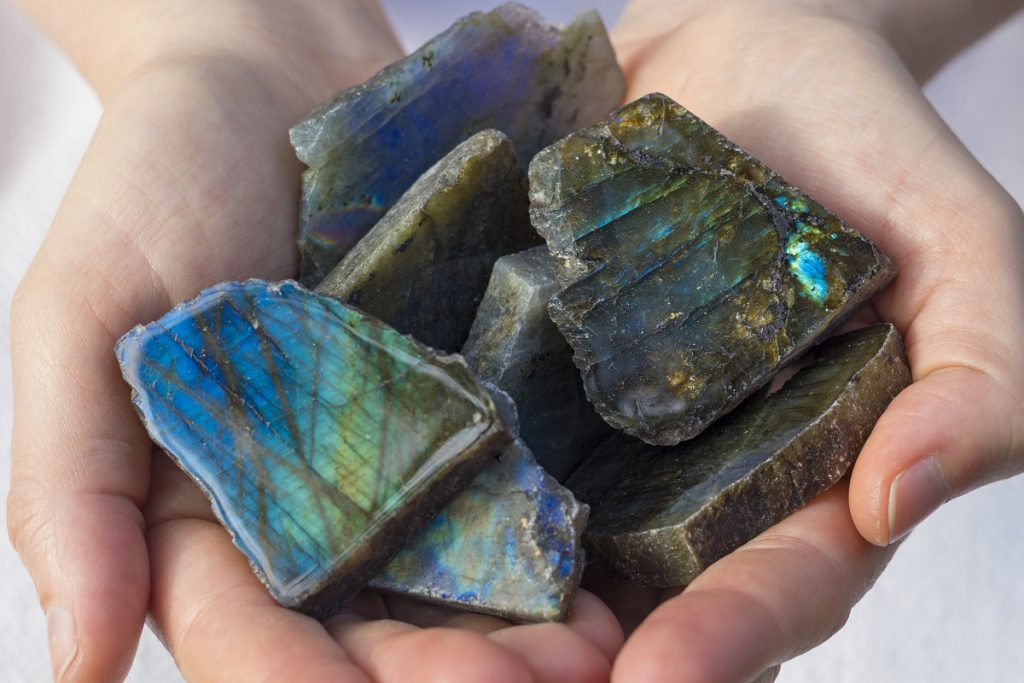Labradorite is highly sought after by collectors. This feldspar-variant displays an amazing iridescent effect depending on the lighting, with flashes ranging from a deep cobalt blue to gold available. There are even more rare specimens for those who truly love the stone.
But what exactly is labradorite? Where is it found? Let’s get to it and you’ll learn the ins and outs of this amazing stone.
What is Labradorite and How It’s Formed
Labradorite is a calcium-rich feldspar, with included crystals that create a peculiar effect in the light. The crystals of labradorite form in a triclinic manner, often lacking symmetry.
Labradorite is most commonly found in formations that occur in other igneous rocks. Where it can be found, the crystals are often contained within gabbro and basalt.
Why Does Labradorite Display a Play of Colors?
While it has a simple chemical makeup, the primary thing that people are looking for with labradorite is the shimmering effect. The color effect often looks like it’s just under the surface of the stone, creating an effect which is known as a schiller luster or labradorescence.
This rare effect only occurs in a couple of other stones. The main one of interest is moonstone, another feldspar-based mineral.
This iridescence’s origin is… complicated. In layman’s terms, we can just say that some of the crystals are oriented in a different position in between the layers of crystal. This creates a surface play effect when the stone is cut correctly.
Labradorite varies a lot in quality. Much of the material is full of cracks and chips, and it has to be cut in the correct direction for the best effect to shine through. Some display very little color at all, while others display a multitude of colors from all angles.
Labradorite ranges from black to white in color, with varying shades of grey in between. Not all of the material displays the optical effect, which is a risk if you’re buying rough material.

What Types of Labradorite Are There?
Labradorite is common on the market these days. It occurs in large formations and the stone is relatively inexpensive compared to many.
Labradorite’s varieties are mostly in the color contained within the surface effect. The most common colors are light blue and gold. These often bleed into each other across the surface of the same stone.
Other common colors include a yellow-orange seen on boundaries of gold-colored bits and a deep cobalt blue that’s highly sought after among collectors and jewelry makers. Purple also occurs, usually in a lighter shade. The purple included in labradorite can become so pale as to be almost silver.
Even the best labradorite can display a weak or heavily off-center flash when they’re cut wrong.
Some colors are very rare, including deep purple and dark reds. These stones are much more expensive than the common varieties, even if both display similar strength of color.
Spectrolite vs Labradorite
There is one kind of labradorite that sticks out, however, and it’s called spectrolite.
Before we discuss spectrolite, let’s make one thing clear: spectrolite is a specific kind of labradorite mined from a specific location in Finland.
Most of what is sold as spectrolite is simply high-grade labradorite.
Spectrolite has a deep purple color in its range that isn’t found in most other varieties, alongside a deep red that is extremely rare. All spectrolite occurs on a black “background” as well, making the colors look more intense.
Labradorite from other locations can display great colors, but spectrolite’s use as a name-brand allows unscrupulous sellers to charge higher prices for stones from different locations.
I recommend being thoroughly familiar with the mineral before paying spectroite prices. I’ll put it this way: if the price of a piece of “spectrolite” seems like a good deal… there’s something wrong. True spectrolite fetches gemstone prices, it’ll be outside the price range of most casual collectors.
That’s not to say that all specimens sold as spectrolite are bad. Many are quite beautiful, they’re just leeching a bit of extra interest by calling it spectrolite. It’s not any shadier than claiming the stone has psychic properties, which seems to be a “feature” of most people selling crystals.

Where Can I Find Labradorite?
Labradorite is mainly found in Canada and Finland and comes from commercial mines. Mindat lists quite a few places across the US, but any serious information is sparse.
The one exception is the Oregon Sunstone Mine which allows some public collection. The stones here are sometimes called red labradorite but differ a lot from the normal stuff. They’re primarily red in color, not flash, and display a golden schiller effect.
If you’re looking for specimens, you may need to purchase them. The following locales are good places.
Local Rock & Gem Store
Most places have a friendly local rock store somewhere nearby. Supporting these shops is important to the community, although you can get stones cheaper online.
Seeing labradorite in person is the best way to avoid getting scammed. Labradorite is a common mineral in the trade, and most shops will have at least rough samples on display.
Rock & Gem Shows
Rock and gem shows are the bee’s knees for finding high-grade specimens or great deals. Bulk deals can end up better than buying online, the problem is that not everyone has a local show.
You can look up a list of gem shows and see if one is near you. If that’s the case, there’s no place better for a rockhound to be! Just set a limit on spending before you step onto the floor. It can be a bit overwhelming if you’re not used to being around beautiful stones.
Purchase Online
You can safely purchase labradorite online, but you need to be savvy about it. Dyed labradorite is a thing, and many newbies can fall into a trap.
Use a reputable middleman if you’re not sure. Amazon and Etsy offer the best protection for buyers, with the latter having a better variety.
You shouldn’t necessarily reject those who sell on social media out-of-hand either. Many of them have great stones at a great price, but it’s a more common spot for scams to show up.
Insist on using Paypal or another protected service when you make a private buy online.
Buying online can bring the best prices and quality… or you can throw your money into the void. A reputable dealer will both answer your questions and provide more pictures or videos when asked.

Labradorite Buyer’s Guide to Getting Good Specimens
Labradorite buying online can be a bit intimidating for the newbie. Not only do you have to avoid bad specimens, but you may also have to contend with fake or treated stones. Most of the latter are obvious, but not all.
You should check all of the following before a buy.
Photos
Not all labradorite has color on the face. Oftentimes the flash will only be visible from off-angles, which is okay for some uses but becomes a problem if you want to, say, set a pendant created from the stone.
Always pay careful attention to the angles of the photographs, especially the “lead” picture. Even I’ve occasionally been bitten by this one, and I go through a lot of labradorite.
Pictures are always taken from angles that are flattering to the stone. The question is just the angle at which the flash is present.
Most reputable sellers will give you a picture from several angles, showing the color play.
Video
Video is the best way to know what you’re getting, and it’s a common feature for eCommerce websites. You want to see a panning view of the stone, giving you a good indication of how colors play out across its face.
No video may be an indication that something is wrong with the specimen, but it’s not 100% standard. Photos from a wide variety of angles can help, but a video is a definitive proof.
Videos are also much more useful in identifying fakes than photos.
Watch for Fakes and Treated Stones
While labradorite isn’t an excessively expensive stone, there are some faked varieties out there.
One newbie trap is simply to dye a stone which shows little to no optical effect. These are often dyed blue, making it look like natural labradorite in photographs. In-person or on video, the blue won’t shift in the same way that untreated material does. Instead, it will remain colored at all angles.
Dyed stones can be identified from pictures most of the time. Look for deeper spots of color and examine how the color looks along the internal lines of the crystal.
The process used to dye labradorite is similar to the one used to color quartz. The stone is heated to high temperatures, creating a ton of internal fractures. It is then placed in the dye, which soaks in through the newly created holes.
The material will have strange straight lines of color in many cases or places where the dye pooled much deeper. The color also doesn’t change with the angle of the stone, which is a huge tell.
In other cases, people have sold actual fake specimens. Most look odd from the first glance, whether it’s color patterns or an internal spiderweb structure. Often mixed dyes will be added, trying to create a similar color pattern to natural labradorite.
This never works out well, the colors in labradorite fade into each other, you won’t see straight lines of blue in gold or vice versa. After you’ve been around a few specimens this is a huge tell. The stones most often sold this way appear to be dyed chalcedony, and upon arrival, they won’t exhibit any optical effects.
While these are both concerns for buyers, those buying stones through legitimate channels will rarely find them. A quick search on major websites shows very few fakes, the majority of them go through private sales to inexperienced collectors.
- Online rock and mineral club for collectors of all levels!
- Find community with like-minded rock and mineral enthusiasts.
- Monthly Giveaways!
- Free Access to Entire Digital Library of Products (annual memberships)


